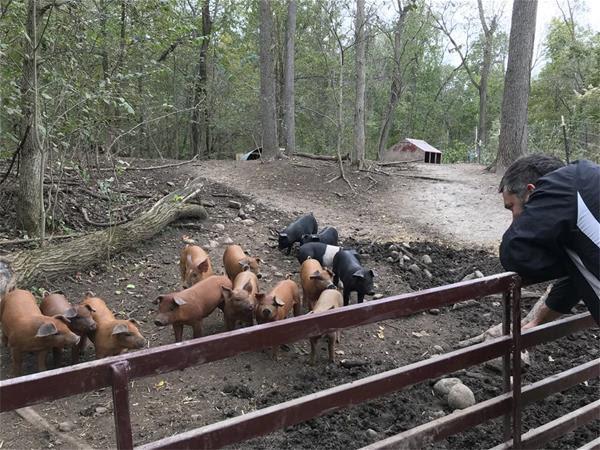Forget the pineapple. These hams start with heritage Duroc pork raised outdoors on pasture on a single farm in northern Indiana. They’re cured and smoked by the meat mavens at Smoking Goose. The result? They’re showstoppers without the extra garnishes.
It all begins at Gunthorp Farm in LaGrange, Indiana.
Greg Gunthorp is a fourth-generation pig farmer. Growing up, his family ran a mixed farm: they raised crops like wheat and soy, but also animals like pigs and chickens. As a kid, Greg’s favorite thing to do on the farm was to go out with his grandfather and feed the pigs. He grew up knowing he wanted to raise his own pigs. But he quickly learned that the economics were not in his favor. In 1998, the market price for his pasture raised pigs was five cents a pound—lower than the price during the depression. But Greg wasn’t willing to give up. So he made the decision to switch from selling pigs to selling pork.
That may not sound that revolutionary. But being able to sell pork meant that Greg needed to build his own abattoir (also known as a slaughterhouse). Thanks to regulations that work to keep us from living in another Upton Sinclair jungle, you can’t just open your own abattoir the same way you can just set up your own butchery, bakery, or candle stick-makery. The immense amount of red tape and paperwork involved in establishing and running an abattoir have essentially squeezed everyone out of the industry except the very biggest players. I asked Greg once how many pig and poultry farmers there are in the US that run their own abattoirs. He didn’t have to pause to think before he answered simply, “Three.”
Greg raises heritage breed Duroc pigs. Greg will tell you they’re not the easiest to raise—compared to today’s conventional pigs, it’s much tougher to get enough piglets from a sow in a year. But he likes them anyway because he loves the deep, rich flavor of the pork. The pigs spend their whole lives out on pasture, in the woods and fields of Greg’s farm. They root around for nuts, roots, and greenery. They’re never given hormones, subtherapeutic antibiotics, or any other growth promotants.
A hundred years ago, this all would have sounded pretty typical to any pig farmer in this country. But today, the vast majority of pigs raised in the US are raised indoors in confinement, standing above giant lagoons of their own waste. It’s more efficient that way, which is to say it costs less. Lower costs means higher profits for the giant companies that own most of the pigs in the US. But they save that money at the expense of animal and worker welfare—and flavor.
Not so with Greg’s pigs, though. They spend their lives doing what they please on the farm. When their time has come, they don’t have miles to travel on a crowded truck to get to the abattoir—instead, they stay on the same property where they’ve spent their whole life. It all adds up to make supremely flavorful pork.
Enter Smoking Goose.
Working in Indianapolis, Smoking Goose cures and smokes a slew of excellent meats, from familiar offerings like city hams to more adventurous choices like jowl bacon. They’re conscientious about all of their meat, and work only with farmers who meet their standards for ethics and sustainability—farmers, in short, like Greg.
This holiday, we’ve partnered with Greg and Smoking Goose to offer an exclusive pecan smoked ham, made only for Zingerman’s. The Duroc hams come from Greg’s farm. The team at Smoking Goose cures them with pepper, coriander, mustard seed, honey, bay leaf and a strawberry-rhubarb cider from New Day Meadery in Indianapolis. Then they smoke the hams over pecan wood.
This is a holiday ham par excellence.
The meat is sweet with a smooth smokiness. It’s complex enough to wow the most discerning palate at the table, yet approachable enough for the pickiest eaters to love it, too. The flavor is a knockout. It will linger with you long after you put down your fork.
The hams are fully cooked, ready to eat. Though it’s not strictly necessary, I’d recommend heating it up in the oven before serving. It’ll add a couple of hours to the prep time, but it’ll also make a stunning, steaming centerpiece on your holiday table.
Heating instructions
- Store your ham in the freezer until two days before you want to eat it, then put it in the fridge. On the day you want to serve it, remove it and let sit uncovered at room temperature for about 1 hour.
- Preheat oven to 325°F
- Remove ham from packaging and place in a shallow roasting pan on a roasting rack.
- Cover the bottom of the pan with water. (You could also mix it up and use stock, wine, cider, or soda.)
- Cover the pan and ham tightly with aluminum foil and bake for approximately 12 minutes per pound, until the internal temperature of the ham reaches 150°F. (Remember that the ham is fully cooked already. Heating it to this internal temperature helps ensure that it’s warm throughout.)
- Optional: If you wish to apply a glaze (not included or required), remove the ham from the oven with about 30 minutes left in your cooking time. Baste with your favorite glaze and return to the oven uncovered. Basting can be repeated several times during the last 30 minutes of heating.
- Remove from the ham from the oven and cover. Allow it to rest for 15 minutes before slicing. There’s no bone, so you can slice all the way through.

